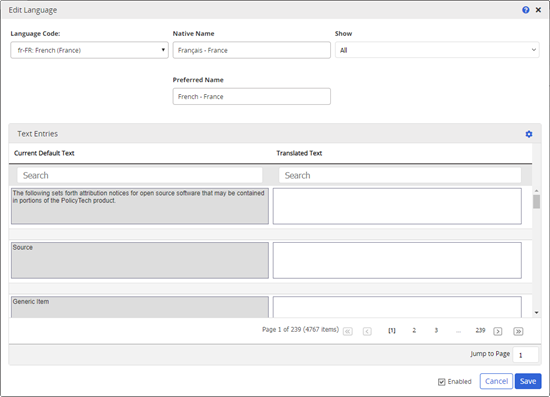Adding Language Files
Policy & Procedure Management provides a diverse group of languages.
Note: Only one language file can be linked to any given language code. If a code has already been assigned to another language file, it will not appear in the Language Code list for this language file.
Add a Language File
- Click Settings & Tools > Tools, and then click Add a Language.
- In the Language Code list, select a code from the available list (see Language File Basics).
- (Conditional) If your organization has purchased one or more language files, you will also see a Default Translation option. Select the translation you want to use as the basis for this new language file.
-
In the Native Name and Preferred Name boxes, type the native and preferred versions of the language name.
-
What you type will appear in the Language menu available when users log in and in other documents and preference settings.
Important: You can set the default language for both the entire organization (see Working with General Properties) and for each site (see Adding a Site).
-
- (Optional) To enable this language and make it selectable by users and administrators, select Enabled.
- Click Save.
- In the Text Entries pane, find text you need to translate or change. Click the language you want to edit.

- In the Translated Text column, type the translations of the default text. To keep a piece of default text, leave the corresponding Translated Text box empty.
- Notes
- The pieces of text (strings) listed in the boxes in the Current Default Text column are the original user interface text strings provided by Policy & Procedure Management. These strings cannot be directly edited. The boxes in the Translated Text column are where you can type the text that will replace the corresponding default text.
- Some default text contains content formatted with HTML tags, such as <br> for a line break, and some default text contains variables. Variables are placeholders that are replaced automatically with specific information, such as a username, when the text is displayed in the user interface. A variable is a number enclosed in percent symbols, such as %1%. You may want to include these tags in the translated text as well.
- Notes
- When you finish editing translations, click Save.
- Click
 to close the Edit Language menu.
to close the Edit Language menu.